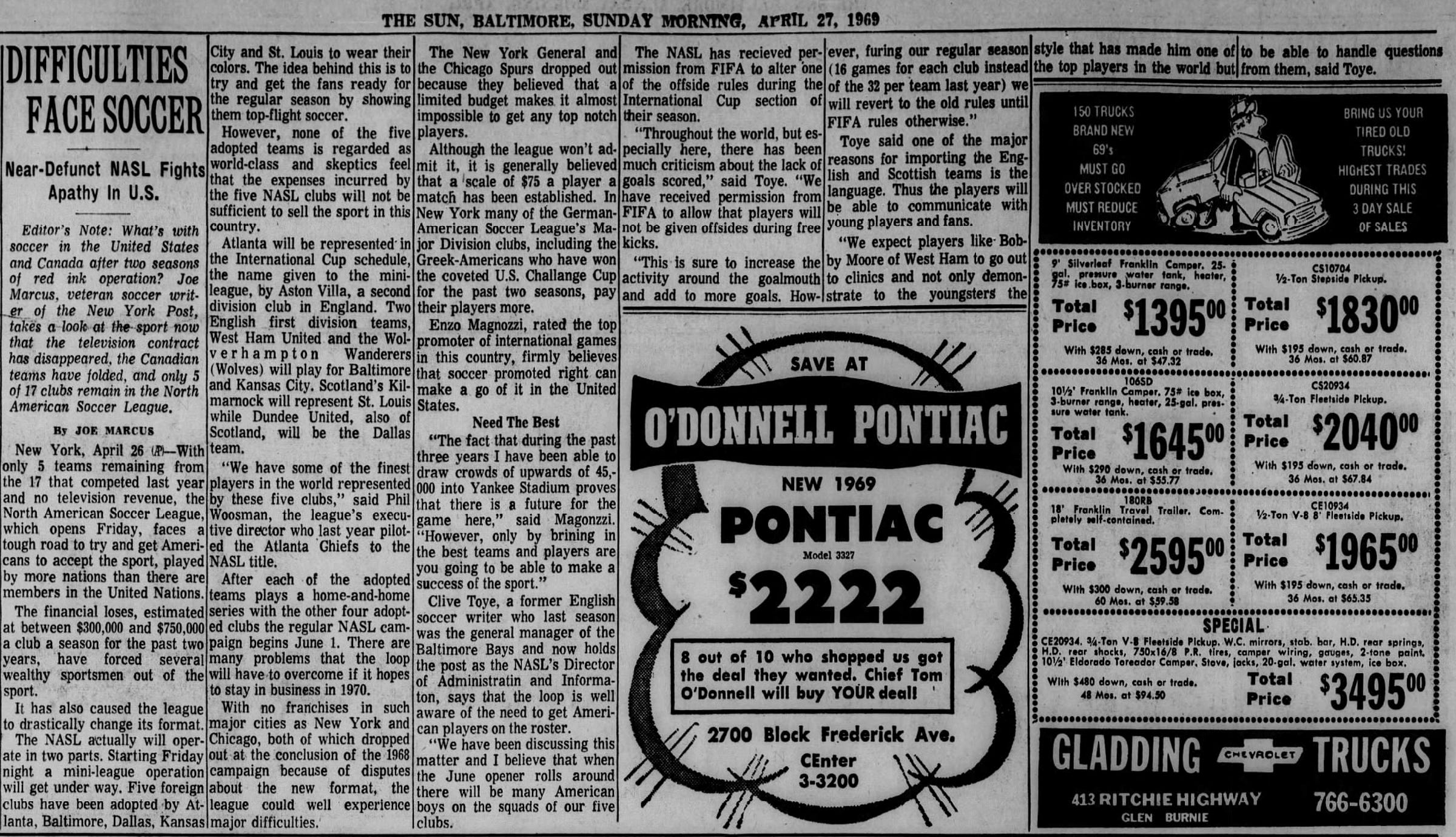Americanizing Football
If you pay attention while you watch old NASL games like this one, you’ll notice that the offside rule was slightly different:
There’s a story behind this. When the NASL decided to bring big time association football to the United States on a professional level, there was a huge debate about what to do with the offside law.
Offside is actually a really easy rule to understand. Unlike American football with its byzantine list of rules and regulations, association football rules are generally easy to understand by simple observation. Even the offside rule in hockey is more complex and harder to understand than football’s rule.
But that simplicity wasn’t enough for the NASL pioneers.
The NASL was struggling to establish a foothold in the American sporting landscape in the late 1960s:
It’s kind of hidden in the article — but there is a hint of things to come here. One club official expressed his preference for hockey’s offside rule, with its extra blue line.
Other newspapers reported similar sentiments from the same administrator:
In fact, Bill Bergesch spent almost all of 1968 complaining about the offside law:
Now, there are a few things we should note here.
First of all, it’s pretty obvious that the American public didn’t really care about the lakc of scoring opportunities in soccer. Crowds of tens of thousands of Americans would turn out for large, established squads, such as Manchester City on their 1968 tour of the United States, and the Santos - Napoli game at Yankee Stadium that drew over 43,000. Shouldn’t the league have focused more on improving the quality of its players and on promoting its own teams instead of completely changing the rules?
Second — it’s obvious that the NASL was trying to grow far too quickly. Having a weekly CBS national broadcast at the very beginning of the league seems a bit optimistic in hindsight. One of the problems with the NASL is that the league didn’t have a lot of room to develop naturally. Instead, its investors demanded an immediate return on investment — despite the fact that no professional soccer league had ever been successful in the United States.
And third, of course, is that the United States was not going to become an international soccer power if it used completely different rules, as this Canadian journalist rightly obseved:
In the end, the tinkering won the day. There was an experiment during the International Cup in the early summer of 1969, in which offside was removed on free kicks:
Now, that International Cup was another bizarre attempt to get Americans to care about the sport. The league imported various teams from England and Scotland and gave them phony names to try to get fans to care:
Note the goal scoring. Wolves scored 25 goals in 8 matches, which arguably means that goal scoring was slightly up as a result of suspending the offside law. Aston Villa, however, only managed 10 goals in 8 matches.
These were desperate times for the league. This highly circulated article indicated that the survival of the league itself was at stake:
Of course, importing foreign teams for a tournament of friendlies isn’t a great way to ensure the survival of your league.
In the end, the NASL did not disappear in the late 1960s — and the chatter about offside continued behind closed doors. The change started halfway through the 1972 season:
Originally, the rule indicated that offside would only be called when the offensive player advanced into the penatly box:
And then, in 1973, the NASL decided to create its own version of the hockey “blue line:”
This image from the Rock N Roll Soccer blog gives you an idea of what those lines looked like:
Basically, offside would only apply past the 35 yard lines that were arbitrarily drawn in front of the penalty box.
Now, if you watch a lot of old NASL matches (as I have), you’ll wonder what all the controversy was about. There weren’t a lot of potential offside calls in midfield that suddenly went away with this rule. Instead, the complicated aspects of this rule caused announcers to spend a ton of time trying to explain it to the television audience.
In the end, the offside law had absolutely nothing to do with the popularity of the NASL. The bonus points for goal scoring, which we will cover in a later post, also had nothing to do with the league’s popularity or survival.
The only thing that really mattered was importing famous players from abroad.
In short - all of the rules tinkering was much ado about nothing.
What do you think about all this rule tinkering?













